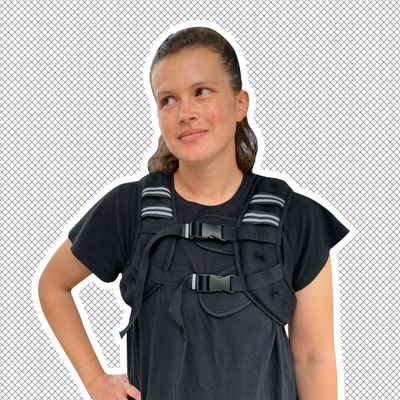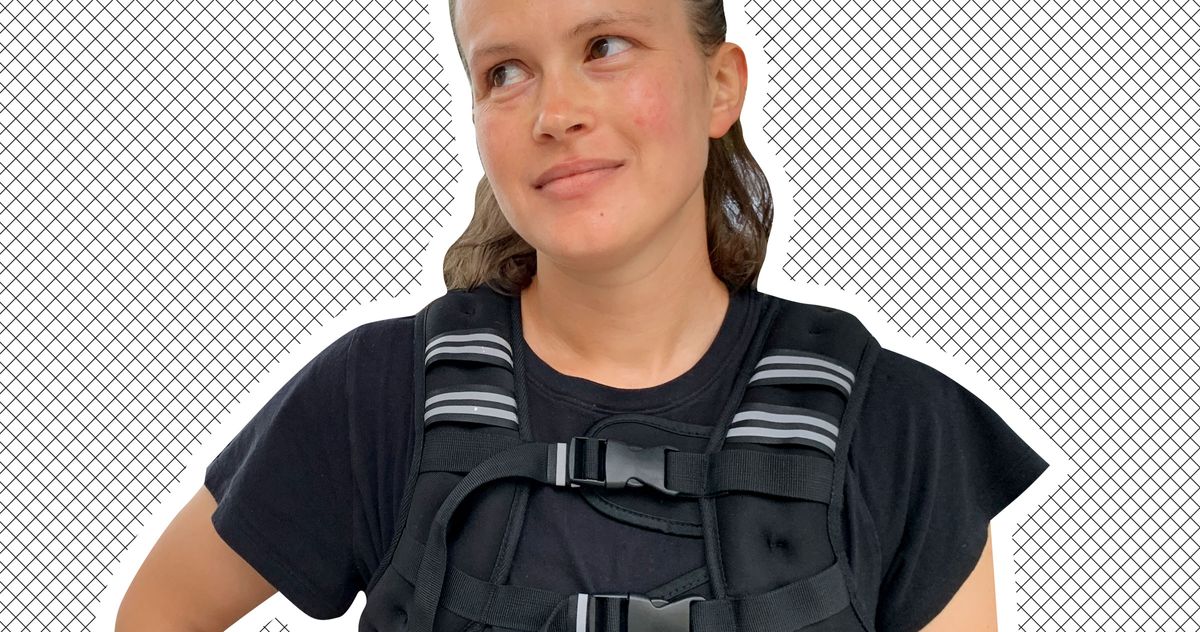
Photo-Illustration: by The Cut; Photo: Erica Schwiegershausen
Lately, weighted vests have been everywhere. TikTok is full of videos proclaiming the benefits of strapping on a 12-pound vest for your hot-girl walk. Jessica Alba filmed herself wearing a weighted vest while running on a treadmill, and Katie Couric tried one out for a stroll on the beach. Kaia Gerber has been seen wearing a particularly sleek one while walking her dog in L.A. Equinox now sells a 20-pound “precision vest” for $375, and Peloton recently launched a series of weighted-vest walking classes designed to “challenge your body in new ways.”
While weighted vests aren’t new, their recent surge in popularity can be traced back to Mary Claire Haver — the OB/GYN the New York Times called “The Menopause Queen” — who frequently films herself wearing one. Haver says she “fell in love” with weighted vests as a way to help her patients with osteoporosis. She claims that by walking or working out in a weighted vest, “you can reap a multitude of benefits, ranging from stronger bones, increased muscle mass, and endurance to improve overall strength,” which she notes is crucial for women as they age.
I’m still years away from menopause, but it feels like everyone I know is talking about how weight lifting has improved their life. After my sister told me she thinks strength training changed her metabolism, I invested in a pair of six-pound dumbbells, which mostly sit untouched in my living room. But I do like to walk, so I was intrigued: Would adding a weighted vest be a shortcut to some of the benefits of lifting?
Most weighted vests look similar to a life jacket that you strap on over your clothes, and they’re typically filled with tiny iron pellets to distribute the weight across your upper back and torso. The market is already crowded with options ranging from the $30 Zelus vest that’s all over TikTok to much pricier, heavier, and more tactical-looking ones. I decided to go with the $30 Prodigen vest that Haver includes in her Amazon Storefront (yes, she earns a commission). She recommends starting with a vest that’s around 5 percent of your body weight and eventually working up to 10 percent. My last pregnancy made my back sore enough that I could barely walk, so I decided to start conservatively with 8 pounds. However, plenty of women on TikTok say they quickly leveled up to 16- and 20-pound vests.
My vest arrived a few days later in a compact but heavy cardboard box. When I tried it on, it was surprisingly comfortable. There was something invigorating about wearing it. I suddenly wanted to stand up straighter and engage my core, like the TikTok videos advise. But it was definitely dorky looking. “You’re going to wear that on a walk?” my husband asked, smirking.
I generally try to avoid wearing things that call attention to themselves, especially when I’m exercising, so I was dreading wearing my vest out of the house. For my first outing, I was relieved it was drizzling so I could hide the vest under a raincoat while I walked to the grocery store. But it was bulky enough that I still felt ridiculous, especially inside the store, where I had to be extra careful not to accidentally bump into someone.
I quickly decided the vest was too embarrassing to wear while running errands. It felt weird to wear it with anything besides workout clothes, and the raised sleeves also make it annoying to carry a tote bag. But it didn’t seem to be making my back sore, so I started taking it on longer walks. After an hour of pushing the stroller on a 90-degree day, taking off the vest felt great. But at the same time, walking around with an extra eight pounds wasn’t that hard. Was it really doing anything? I wondered whether I should buy a heavier one.
Going for a walk and listening to a podcast is usually one of my favorite activities. But while pages of Amazon reviewers gush about how much they love their vests, I mostly found it tedious. The extra weight made me feel constrained and awkward in a way that reminded me of pregnancy or walking with a baby carrier. It didn’t take long for me to start to resent the vest lying on the floor next to the front door, nagging me to make every trip out of the house a little less enjoyable.
As it turns out, my weighted vest probably wasn’t doing much. “It’s being marketed as a one-stop fitness solution that is good for bone health and has benefits for muscle, and you can get those benefits from going on a couple of 30-minute walks per week,” says Lauren Colenso-Semple, a muscle physiology researcher at McMaster University. “But the evidence just does not support that.”
Colenso-Semple points out that most of the studies influencers cite to illustrate the benefits of the vests actually don’t involve walking. For example, the paper that Haver references when she claims that weighted vests can help improve bone strength looked at women who wore vests while jumping. It’s a relevant distinction, since experts say high-impact exercise — like jumping — is beneficial for maintaining bone density (as opposed to walking, which is low impact). “There’s only one study that I’m aware of that looked at walking,” says Colenso-Semple, referring to a 2011 paper that looked at 48 women and found no difference (for bone health or otherwise) between women who walked with a weighted vest and those who walked without one.
It’s worth noting that both of these studies are very small — as are most of the studies cited by influencers pushing weighted vests. “I’m not saying it doesn’t work, but the actual evidence is quite limited,” says Lora Giangregorio, a researcher in bone health and exercise science at the University of Waterloo who thinks walking in a weighted vest is “a waste of time.”
While weighted vests were initially pitched as a way for menopausal women to get stronger, it didn’t take long for women on TikTok to start claiming that adding one to their daily walk helped them lose 30 pounds. But while wearing a vest might help you burn a few more calories — assuming it’s not so heavy that it slows you down — it does not appear to be a magic weight-loss hack. Colenso-Semple points out that in one commonly cited study, participants wore a weighted vest for eight hours a day. Even then, people who wore a vest that was 11 percent of their body weight only lost 1.6 kilograms — about 3.5 pounds. Another study, in which participants tried to wear a vest for ten hours a day, found no additional benefit for weight loss — though some people did report a sore back.
Obviously, walking with a weighted vest can make it more challenging. But Giangregorio says that if your goal is to increase cardiovascular fitness, there are plenty of other, potentially more satisfying ways to do that, like walking on an incline, walking faster, or jogging.
If your goal is to build muscle, there’s no shortcut around strength training, says Colenso-Semple. “You can use dumbbells, you can use machines, you can use barbells — but there has to be some resistance,” she says. Experts say that wearing the vest could be helpful to add resistance while you’re doing squats or lunges. But even then, the amount of weight you could reasonably add with a weighted vest might not be challenging enough, since to build muscle, you need to make the exercise harder over time.
“The key is to pick a version of the exercise that’s quite challenging, so you can only do somewhere between six and 12 reps,” says Giangregorio. “That’s a much more efficient way to build muscle than doing an activity you can do for 30 minutes.”
Definitely not. Personally, I’m thrilled to return to walking around unburdened by extra weight, and I’ll stick to jogging when I want something harder. This experiment did motivate me to do a few more push-ups, though.
Stay in touch.
Get the Cut newsletter delivered daily
Vox Media, LLC Terms and Privacy Notice
Related
